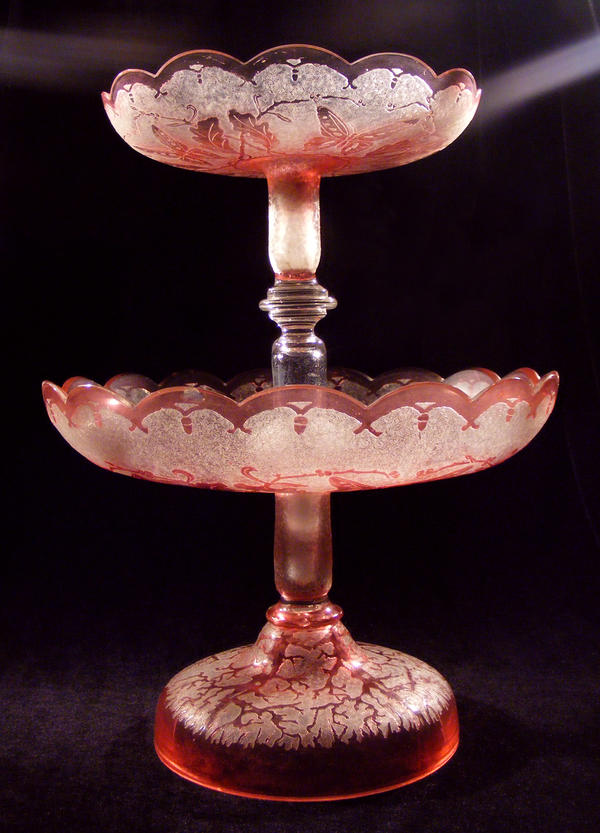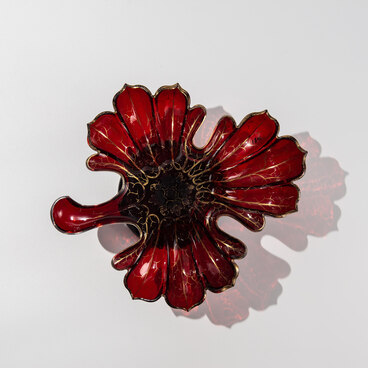The term “pyramid” is used by the Russian glass factories to refer to dessert vases that consist of several bowls of various diameters joined together by a rod through the hole in the center. The upper bowls are smaller than the lower ones. A tiered table centerpiece was an integral part of all Russian services of the 19th–20th century and was also known as an “epergne”.
The top bowl of the three-tiered vase has been lost. The vase is made of two-layer glass. The bottom layer is made of colorless glass, and the top layer is made of pink glass.
The color is obtained by using gold compounds. Red glass of various shades, from scarlet to purple is known as “ruby glass” or simply “rubies”. The “gold ruby” is the red-purple glass that contains fine particles of metal gold that can only be seen in finished products under a microscope with high magnification.
The “gold ruby” is one of the most beautiful and expensive types of art glass. Depending on the heating conditions, glass painted with gold can take on such shades as pink, purple, and sometimes even blue. The Dyatkovo Crystal Factory mastered the process of making the “gold ruby” glass in the first half of the 19th century and produced such items for over a century.
The bowls are decorated with interwoven patterns of oak leaves, acorns, and butterflies. The stable leg of the vase is decorated with an expressive pattern resembling strong entangled oak roots. The elaborate pattern was made using the etching technique with hydrofluoric acid. Its natural motifs are typical of the Art Nouveau style that was incredibly popular in late 19th century Russia. With its curved and flowing lines and wavy natural patterns, the Art Nouveau style resonated with glass art, which helped to reveal its full potential. During that period, the craftsmen of the Dyatkovo Crystal Factory turned to nature to find inspiration for the shape and decoration of their products. Being familiar with the Art Nouveau glass products manufactured in Europe, they contributed their own technological and artistic ideas to create a unique and inimitable style.
The top bowl of the three-tiered vase has been lost. The vase is made of two-layer glass. The bottom layer is made of colorless glass, and the top layer is made of pink glass.
The color is obtained by using gold compounds. Red glass of various shades, from scarlet to purple is known as “ruby glass” or simply “rubies”. The “gold ruby” is the red-purple glass that contains fine particles of metal gold that can only be seen in finished products under a microscope with high magnification.
The “gold ruby” is one of the most beautiful and expensive types of art glass. Depending on the heating conditions, glass painted with gold can take on such shades as pink, purple, and sometimes even blue. The Dyatkovo Crystal Factory mastered the process of making the “gold ruby” glass in the first half of the 19th century and produced such items for over a century.
The bowls are decorated with interwoven patterns of oak leaves, acorns, and butterflies. The stable leg of the vase is decorated with an expressive pattern resembling strong entangled oak roots. The elaborate pattern was made using the etching technique with hydrofluoric acid. Its natural motifs are typical of the Art Nouveau style that was incredibly popular in late 19th century Russia. With its curved and flowing lines and wavy natural patterns, the Art Nouveau style resonated with glass art, which helped to reveal its full potential. During that period, the craftsmen of the Dyatkovo Crystal Factory turned to nature to find inspiration for the shape and decoration of their products. Being familiar with the Art Nouveau glass products manufactured in Europe, they contributed their own technological and artistic ideas to create a unique and inimitable style.



